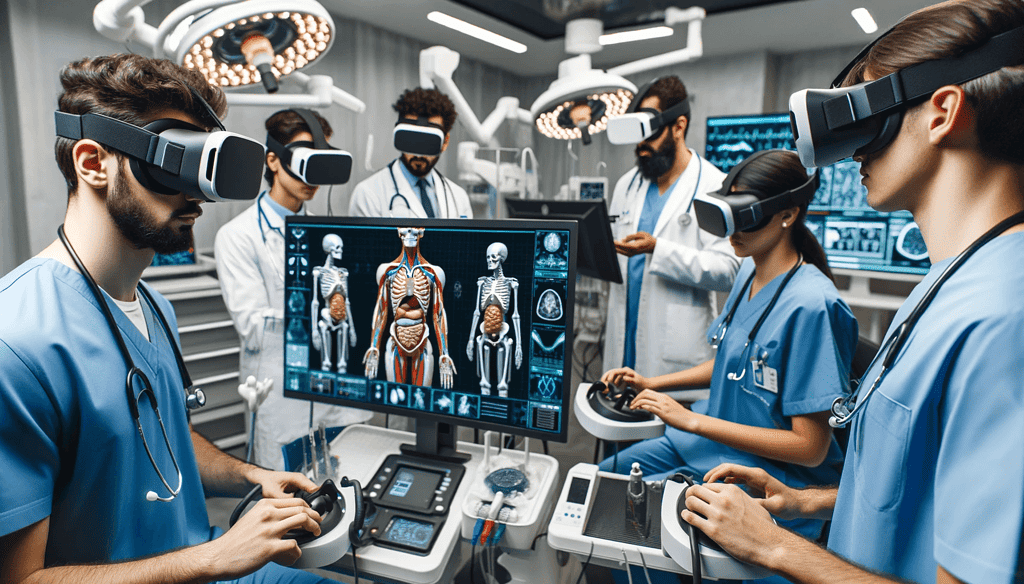

The medical landscape is undergoing a groundbreaking change through the use of virtual reality (VR). This technology has the potential to revolutionize the performance of surgeries, the application of therapies and the training of medical professionals. The technology also enables an immersive experience in a computer-generated world, taking the practice to a new level of precision and understanding.
Simulation as preparation for real interventions
Surgeons can simulate operations using VR, which not only enables risk-free training, but also serves as a navigation aid during real operations. This technology helps to increase patient safety and also improve the precision of surgeons.
VR integration into everyday clinical practice
However, the implementation of VR in everyday clinical practice is not without its challenges. Costs, seamless integration into existing procedures and staff training are key factors that need to be taken into account.
VR in the treatment of phobias and PTSD
Virtual reality has proven to be particularly valuable in the treatment of phobias and PTSD. Patients can confront their fears in a controlled and safe virtual environment, which supports a gradual healing process.
Need for research into long-term therapeutic effects
Although the method has shown success, further studies are needed to understand and subsequently optimize the long-term effects and efficiency of VR therapies.
Risk-free learning and practicing
Medical students can immerse themselves in human anatomy through VR and practice complex procedures without putting real patients at risk. This promotes a deeper understanding and the development of practical skills.
The debate: Can VR replace real experiences?
The question of whether VR-based experiences are capable of completely replacing hands-on experience is a critical point of discussion that continues to require attention.
Technical limitations and the lack of haptic feedback
VR is an impressive simulation, but it cannot fully capture the complexity of reality. The lack of haptic feedback is a significant limitation, especially in medicine where touch is crucial.
Accessibility and cost efficiency
The cost of VR technology can be a barrier for smaller medical facilities. It is important to make innovations accessible globally to avoid creating new inequalities in healthcare.
Data protection: a central aspect
The security of patient data generated in VR simulations is of paramount importance to ensure privacy and data protection.
The integration of VR into medicine offers immense possibilities and is a sign of technological progress. However, to realize its full potential, the technology must be used responsibly. It is therefore crucial to take ethical and practical considerations into account and also to find a balance between technological innovation and human care. Only through a prudent approach can we maximize the benefits while minimizing the risks to ensure sustainable and effective integration into the healthcare system.
Virtual reality in medicine refers to the use of computer-generated, immersive environments to support medical applications. These range from surgical simulations to therapeutic measures and training scenarios. The technology offers new possibilities for training medical professionals and treating patients in a targeted manner.
VR is already being used in a variety of ways in medicine today: Surgeons train complex procedures in simulated 3D environments, patients with phobias or post-traumatic stress disorder (PTSD) undergo targeted training in VR. VR Therapyand students experience practical training formats. Virtual Reality Healthcare enables realistic, risk-free preparation for medical challenges.
The advantages of Virtual Reality in medicine lie in increased safety, better learning curves, improved patient loyalty and individualized therapy design. Integrating VR into medicine means making diagnostics and treatment more interactive and effective.
VR Therapy PTSD and VR Therapy Phobia use immersive scenarios to confront patients with anxiety-inducing situations in a controlled manner. Gradual habituation (exposure) can lead to a significant improvement in symptoms - particularly in the case of anxiety disorders, trauma or social phobias.
VR in medicine not only enables future doctors to learn in a realistic, safe and interactive way. Students can also use VR systems to explore complex anatomical structures or simulate surgical procedures. Virtual reality in medicine improves preparation for real clinical situations and promotes knowledge transfer.
Virtual reality healthcare is increasingly being used in pain therapy. This is because pain can be alleviated through distraction, relaxation and targeted perception control in a virtual environment. VR-based applications have positive effects, particularly for chronic pain patients or in the post-operative phase.
Virtual reality in medicine requires powerful VR headsets, suitable software solutions and a secure data infrastructure. Ergonomics and hygiene (e.g. disinfectable headsets) are also essential in the medical environment. The systems should be intuitive to use and easy to integrate into existing processes.

Are you interested in developing a virtual reality or 360° application? You may still have questions about budget and implementation. Feel free to contact me.
I am looking forward to you
Clarence Dadson CEO Design4real






